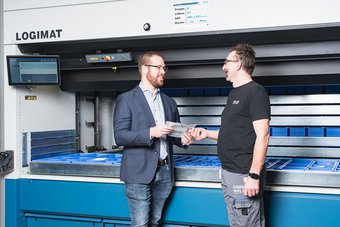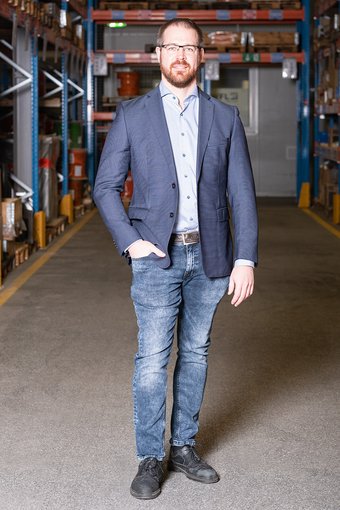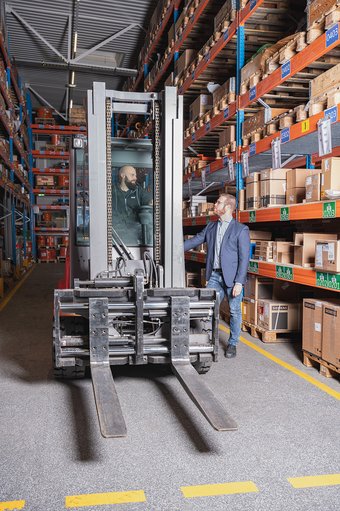Keeping everything running smoothly
Just like any gear mechanism, be it in a car, a watch or anything else, smooth operation is essential and protects against stoppages.
This equipment must be oiled and lubricated, not to mention calibrated and aligned, in order to work quickly and precisely. Historically speaking, logistics originated in the military, its long story extending from Ancient Rome all the way to the world wars of the 20th century and into the present era. But the tasks that we all associate with logistics nowadays, such as transport, handling and storage, did not come about until the 1970s, when they first began to improve overall economic success. In our modern world, there’s no disputing the importance of logistics development. And that’s true at WFL too. By constantly improving our processes year after year, we can ensure that our diverse workflows get completed on time, all while being perfectly structured and scheduled. Functional areas such as internal and external transport, handling, warehousing, inventory management, goods inspection, packing, information logistics and warehouse logistics are all just the tip of the iceberg. In 1989, Reinhardt Jünemann formulated the pragmatic task of logistics as follows: “The logistical task consists in providing the right quantity of the right objects as logistics items at the right place in the system, at the right time, in the right quality, and at the right cost.”
To keep up with the latest trends and developments, the WFL logistics department is constantly working on new solutions and workflows. As the department head, Alexander Hofmann brings structure, speed and precision to the proceedings, and keeps an essential part of the WFL machinery moving.
Mr Hofmann – over the last few years, you’ve brought a fresh perspective and, most importantly, new impetus to logistics at WFL. Could you tell us a bit about yourself, and give us an insight into how it all began?
After playing competitive sports in high school, I began to think about what sort of education I should pursue. My path led me to commercial college, where after much deliberation I realised that I didn’t want to go down the academic route, and instead took up an apprenticeship as a forwarding agent. At that time, logistics was still a foreign word to me, but it al- ways sounded very exciting compared to the standard office-based admin jobs.
Over the years, I gradually worked on my personal development, and was able to amass plenty of experience and expertise in a wide variety of fields. Nowadays, I try to bring together all of what I’ve learned, and – most importantly – put it to good use. I joined WFL in March 2019. Early on, I held one-on-one meetings with my team to establish the status quo, so that I could work out where there was potential for improvements to be made. The wealth of information I gleaned from these mee- tings still serves as my starting point today whenever I’m tackling new issues or improving existing ones. My aim is to achieve a permanent flow of refinement and optimisation.
What is your preferred leadership style?
The most important thing is an open and honest approach; good mutual cooperation and, above all, communication. Every employee is an important part of the whole. Personal responsibility is essential, but it’s also vital that we all pursue a common goal. In our weekly meetings with the teams and team leaders, we always try to establish a common and unified basis for communication, so that we’re ideally equipped for whatever we face.
How do you manage your work-life ba- lance?
My wife would say that I don’t have a work-life balance! That’s true to some degree, but these days it’s not easy to find the balance that’s needed. I played a lot of sports in my youth, but sadly I don‘t have as much time for that nowadays. But, with the help of my very understanding wife, I‘ve found ways to combine work and sports to achieve some semblance of balance. During the week, I focus on work, which often continues after I’ve returned home and into the evening. I hold phone calls with my colleagues on the second shift, since there are various matters that need coordinating. Ideally, my weekend begins on Friday afternoon, where I make the most of the time with my family. I also find some time to recharge and fit in one or two sporting activities.
Do you get so wrapped up in certain things that you forget to eat and drink?
Yes, absolutely! There have been occasions where I’ve taken my unopened lunchbox back home with me at the end of the day because I’ve simply forgotten to eat or drink. Of course, that’s not healthy, but if something is important to me, I go all in. In these situations, I want to complete my tasks and use all the resources available to me in order to achieve my goal with speed and precision.
On the whole, how does logistics work at WFL and how is warehousing managed? Or in other words, what does the flow of goods look like?
In principle, the picture has changed dramatically over the last two years thanks to a variety of optimisations. Conversions, new operating systems, new processes and organisational improvements have enabled us to cut lead times considerably. It all begins at inbound logistics, where all the goods are delivered. This is where we do an initial check of quantities and documents. The goods are also inspected for damage, and any findings are noted. In the inbound logistics office, everything is then digitalised and saved in SAP. In the next step, a goods receipt slip is generated and everything is prepared for storage or immediate processing on the MILLTURN. Some goods are also subject to quality controls, and defective ones are ejected from the process or undergo quality assurance measures. Finally, the goods are stored in the high- bay warehouse or in the automatic small parts storage lift system. Another zone found here is outbound logistics, which is the area for outgoing goods and dis- patching. It’s mainly packing and loading activities that are carried out here, but this includes a large number of small, secondary aspects. And finally we have the distribution logistics department, which manages the overall workflow and coordination. Transport runs are organised here, and commercial and customs processing is managed.
Which processes or achievements are you particularly proud of?
I’m proud of all the improvements to pro- cesses that we have been able to implement to date. One of our prestige projects is the automatic small parts storage lift system. We made the conscious decision to invest in the technology and get it up and running. It was a large, ambitious project that had to be completed on a tight schedule. Nonetheless, thanks to a huge combined effort, we achieved everything we had set out to do.
Who or what comes to mind when you hear the word “successful”?
WFL comes to mind (smiles)! But it’s important to remember that “success” has many facets. In your personal life, for ex- ample, you might have the goal of seeing your children grow up happy, or having a long and harmonious relationship with your partner, but you can also aspire to face and overcome challenges. To me, success ultimately means bringing about positive changes and using them to their best effect.
What values do you appreciate most in your employees?
That’s difficult to answer, since everyone is unique and has their own strengths and weaknesses. But in general, our entire team is made up of helpful, supportive, resourceful employees who – crucially – play an active role in bringing about improvements. They always look out for one another, even in difficult or stressful situations, and give their all for the team and the entire department.
How do you deal with difficult situations in logistics and how are they managed?
First of all, it’s important to really get to grips with difficult topics. You’ve got to ask where the problem actually lies. Identifying and analysing are the first steps and are essential for all the subsequent actions. It’s also important to seek input from everyone who is involved in the process chain. The entire workflow has to be considered so that errors can be mitigated in advance. And once a difficult situation has been resolved, it’s essential to follow up on that process. The questions that should be asked are things like: Can the implemented solution be maintained? Will this solution be accepted? Was this a positive step in the right direction? All of this needs to be reviewed and incorporated into the process.
What three attributes best describe logistics at WFL?
I could name many attributes here, but I’ll try to compress them. Speed, flexibility and quality. The principle of the “7 Rs” also comes to mind here. Logistics is about providing the right product, in the right quality, at the right time, in the right place, in the right quantity, with the right information, and at the right cost. This principle is the overarching objective in our department. And last but not least, we’re extremely agile when it comes to working across teams. For instance, we compensate for potential postponements and/or any fluctuations as quickly as possible in order to prevent delays.
When everything is running as it should, logistics is like a well-oiled machine. How do you keep things running smoothly, and what is necessary to do that?
What’s important is the human factor. The employee is an essential resource on which lots of things depend. Further training and education, providing information on time, and being a good listener are all essential. The infrastructure and associated resources, such as the IT structure, are also of great value in ensuring smooth operations. Stable, well-established processes are also needed. In my view, these processes should follow the mantra of “keep it simple” – and should be treated as such. I believe that tricky processes have to be simplified, as complex methods are usually much more susceptible to errors than a straightforward, well-thought-out process.
Successful logistics requires a suitable IT infrastructure. How is this deployed, and what are the essential processes?
Without IT, nothing in logistics would function. To be honest, that’s true not only for us but for all the other departments too. Things can only work properly with a stable and sophisticated structure – and thankfully, that’s what we have. PCs, scanners and a variety of hardware components are all essential, along with the associated software, in order for us to optimise our workflows from an information technology and data technology perspective.
What are the daily tasks on your schedule? Are there any routines?
Yes, there are some basic routines that I have chosen for myself and put into practice. In the morning, I look over the latest basic figures. Where are we right now? Which order requirements are pen- ding and which of them have priority? I then do the rounds of the various teams, coordinating with the team leaders, deputies, and employees in order to build up a picture of the current situation. I then check my upcoming meetings so that I can prepare for them. The rest of the day unfolds more intuitively, shaped as it is by a wide variety of factors. I could be working on ideas put forward by employees, troubleshooting, or supporting the team. In any case, I try to be as prepared as possible for the day, so that I can use the time most effectively.
What does the future look like for WFL – where do you see it in 5 to 10 years? What measures and improvements are essential in order to make progress?
I feel very positive on this particular point, and I believe that we’ll manage to achieve the target sales figures within this time period. I see WFL as a full-service provider with all its facets. Doing the heavy lifting here are things like second-hand machines, after-market sales, and a range of other services. But it’s also going to be important to ensure that the structures grow with the company. Processes such as digitalisation, as we’ve already spoken about, also have to be kept up to date so that we can stay ahead of the curve. And of course, automation has a promising part to play in the future. I’m confident that WFL meets and will continue to meet all these criteria in order to remain successful well into the future.





